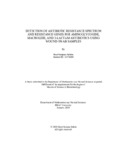| dc.contributor.advisor | Haque, Fahim Kabir Monjurul | |
| dc.contributor.author | Jinnah, Mst. Maskera | |
| dc.contributor.author | Fatema, Kaniz | |
| dc.date.accessioned | 2024-10-29T04:45:52Z | |
| dc.date.available | 2024-10-29T04:45:52Z | |
| dc.date.copyright | ©2024 | |
| dc.date.issued | 2024-07 | |
| dc.identifier.other | ID 19226010 | |
| dc.identifier.other | ID 19126005 | |
| dc.identifier.uri | http://hdl.handle.net/10361/24463 | |
| dc.description | This thesis is submitted in partial fulfillment of the requirements for the degree of Bachelor of Science in Microbiology, 2024. | en_US |
| dc.description | Catalogued from PDF version of thesis. | |
| dc.description | Includes bibliographical references (pages 35-39). | |
| dc.description.abstract | The Acinetobacter baumannii is a gram-negative coccobacillus also known as opportunistic
bacterial pathogens currently creating great concern in clinical aspects due to their capacity to
endure for extended periods of time in the environment and ability to cause multi-drug
resistant infections. The objective of the study was to identify A. baumannii from hospital
environments and admitted patients in hospital to analyze their antibiotic resistance, serum
resistance and biofilm formation. Total 450 samples were collected from different wards of
Rajshahi Medical College and Hospital. Among them we obtained 53 isolates of A. baumannii
confirmed by polymerase chain reaction by targeting of the blaOXA-51 gene. From 53
isolates, 20 were from patient’s samples (7 endotracheal aspirates, 4 blood, 5 wound swab, 2
throat swab and 2 catheter tube ) and 33 isolates were from environment’s samples (bed sheet,
surface of furniture, nebulizer machine, floor, nurse’s hand swab, food cart, medicine cart and
trolleys). Subsequently, an antibiotic susceptibility test was done. Isolates from patient
specimens were resistant to gentamicin (90%), amikacin (90%), cefepime,
piperacillin-tazobactam (85%), ceftazidime(85%), and tetracycline (80%). A significant
proportion of the isolates, 70%, displayed resistant against levofloxacin, imipenem,
meropenem. Most importantly, 90% of all patient isolates were MDR. On the other hand,
hospital environment’s isolates were resistant against ceftazidime(100%), imipenem(87.9%,),
piperacillin-tazobactam (78.8%), and cefepime(78.8%). A significant proportion of the
isolates, 69.7% and 66.7% were resistant against meropenem and gentamicin. Among them
80% of all isolates were MDR. The result of the serum bactericidal assay showed that almost
31% of isolates were serum resistant and 35% were sensitive and 34% were intermediate.
Isolates from the environment's samples were 10% more resistant than the isolates from the
patient's samples. Among environment’s isolates 36% isolates were resistant whereas among
patient’s isolates only 26% were resistant. According to quantitative biofilm formation
results, among 33 environmental isolates 17% of isolates formed strong biofilm, 14% formed
moderate film, and 30% formed weak and 39% isolates did not form biofilm. | en_US |
| dc.description.statementofresponsibility | Mst. Maskera Jinnah | |
| dc.description.statementofresponsibility | Kaniz Fatema | |
| dc.format.extent | 40 pages | |
| dc.language.iso | en | en_US |
| dc.publisher | Brac University | en_US |
| dc.rights | Brac University theses are protected by copyright. They may be viewed from this source for any purpose, but reproduction or distribution in any format is prohibited without written permission. | |
| dc.subject | Acinetobacter baumannii | en_US |
| dc.subject | Multi-drug resistance | en_US |
| dc.subject | Antibiotic resistance | en_US |
| dc.subject | Serum resistance | en_US |
| dc.subject | Biofilm formation | en_US |
| dc.subject.lcsh | Drug resistance in microorganisms. | |
| dc.subject.lcsh | Biofilms--growth & development. | |
| dc.title | Isolation of Acinetobacter baumannii from patient and hospital environment: analyzing their antibiotic resistance, serum resistance & biofilm formation | en_US |
| dc.type | Thesis | en_US |
| dc.contributor.department | Department of Mathematics and Natural Sciences, Brac University | |
| dc.description.degree | B.Sc. in Microbiology | |




